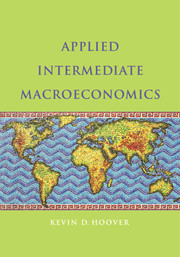Book contents
- Frontmatter
- Brief Contents
- Contents
- Acknowledgments
- To the Student
- To the Teacher
- Part I Introduction
- Part II The National Accounts
- Part III Trends and Cycles
- Part IV Financial Markets
- Part V Aggregate Supply
- 9 Aggregate Production
- 10 Economic Growth
- 11 The Ideal Labor Market
- 12 Unemployment and the Labor-Market Process
- Part VI Aggregate Demand
- Part VII Macroeconomic Dynamics
- Part VIII Macroeconomic Policy
- Part IX Macroeconomic Data
- Symbols
- Glossary
- Guide to Online Resources
- Index
9 - Aggregate Production
from Part V - Aggregate Supply
Published online by Cambridge University Press: 05 June 2012
- Frontmatter
- Brief Contents
- Contents
- Acknowledgments
- To the Student
- To the Teacher
- Part I Introduction
- Part II The National Accounts
- Part III Trends and Cycles
- Part IV Financial Markets
- Part V Aggregate Supply
- 9 Aggregate Production
- 10 Economic Growth
- 11 The Ideal Labor Market
- 12 Unemployment and the Labor-Market Process
- Part VI Aggregate Demand
- Part VII Macroeconomic Dynamics
- Part VIII Macroeconomic Policy
- Part IX Macroeconomic Data
- Symbols
- Glossary
- Guide to Online Resources
- Index
Summary
This chapter returns to the problem of explaining the real economy. We begin with aggregate supply. What determines how much GDP the firm sector wants to produce? What determines how productively the economy uses labor and physical inputs to production? How does the business cycle affect the use of inputs – especially the level of employment? An understanding of aggregate supply sets the stage for Chapter 10, in which we examine economic growth in the long term, and Chapters 11 and 12, in which we examine labor markets.
In Chapters 2–5 we learned what GDP and its components are, how they typically behave, and how they appear to be related to inflation, employment, industrial production, and other variables. It is now time to turn from description to explanation. Examples of the kind of questions that we would like to answer include:
Why is GDP in the United States vastly higher in 2010 than in 1960 or 1910?
Why is GDP in the United States higher than in any other country in the world?
Or, more specifically:
What would happen to GDP if immigration rules were relaxed and 5 percent more workers joined the U.S. labor force?
How much should we expect employment to fall in a recession or rise in a boom?
- Type
- Chapter
- Information
- Applied Intermediate Macroeconomics , pp. 309 - 352Publisher: Cambridge University PressPrint publication year: 2011



